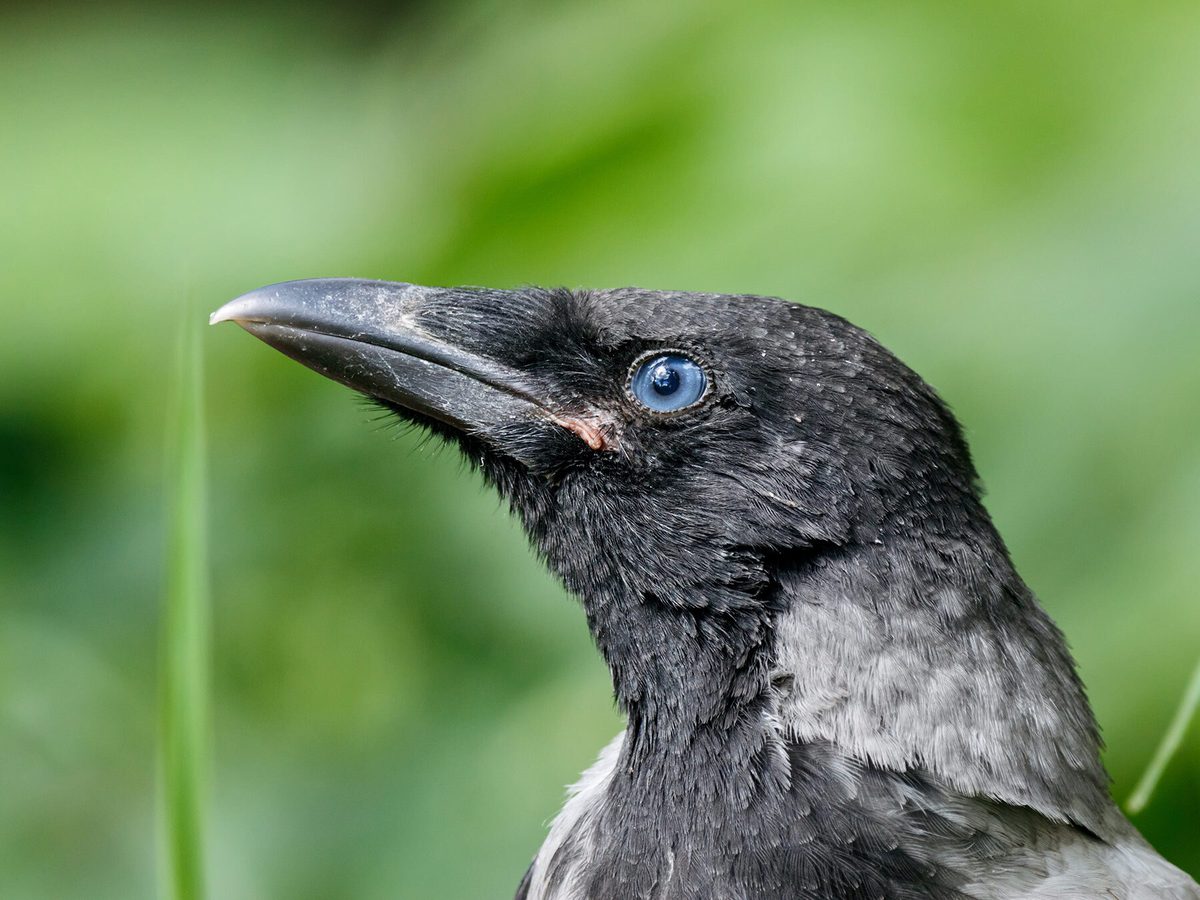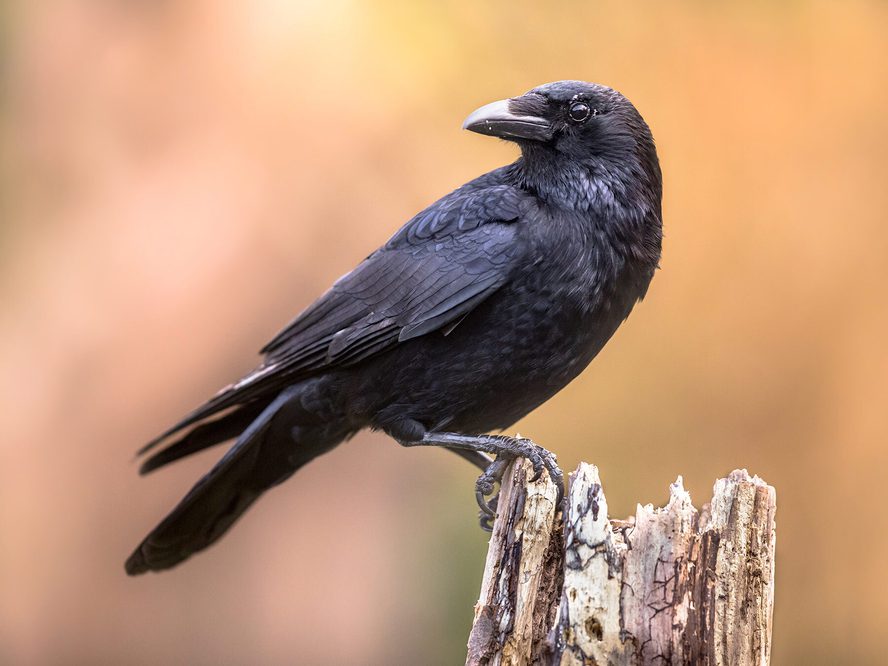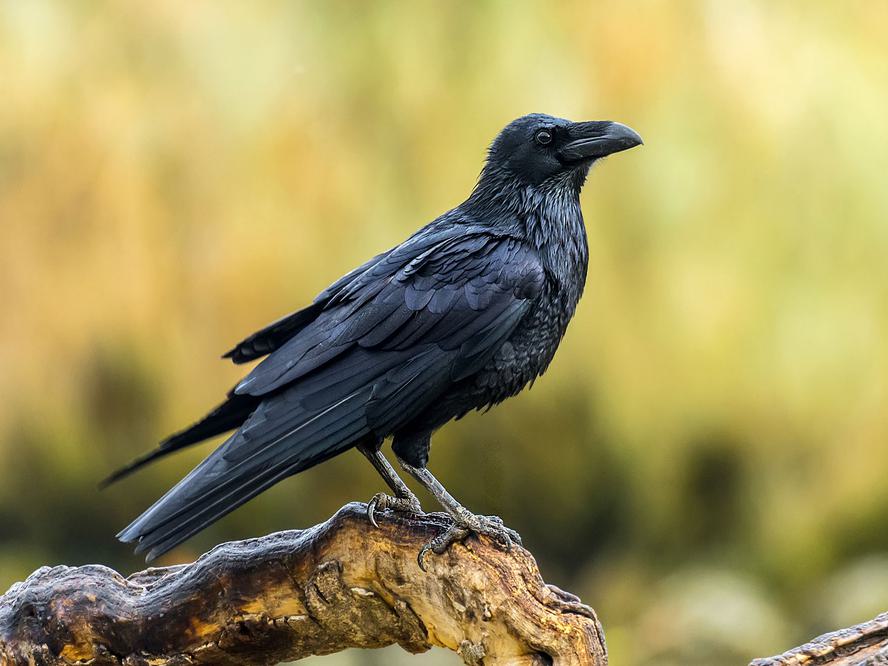Jump to Section
Baby Crows: All You Need to Know (with Pictures)
Last updated: 14 March 2022

Crows, from the Corvus genus of the Corvidae family, are exceptionally intelligent birds. Not only are crows excellent at completing advanced problem-solving tasks, but they’re even capable of abstract thought and may even think in a similar way as we do.
So what about baby crows? Baby crows are a relatively rare sight, and there are good reasons why many people never see one.
This article will delve into everything you need to know about baby crows, and there will be plenty of photos of the elusive baby crow along the way!
What does a baby crow look like?
The chicks of most species of crow hatch with a light covering of shaggy and fluffy feathers.
Some crow nestlings are almost naked and have large, pinkish bills. Another remarkable characteristic of baby crows is their blue eyes which make crow chicks and juveniles reasonably easy to spot amongst adults.

Newly hatched Crow chicks in the nest, being fed by one of their parents
How big are baby crows?
Baby crows are just a few centimetres long when hatched but grow rapidly, achieving much of their adult size before fledging the nest after a month or so.
The species in the crow family that actually contain ‘crow’ in their common name are quite similarly sized, for example, the smallest, the Little crow, measures 42 to 48cm in length, whereas the largest crows only measure 55cm or so at the most.
Whilst the much larger ravens are also in the same genus as crows, they do not contain the name ‘crow’ in their common name - but they are in some way still crows - but that’s a discussion for another time!
How much do baby crows weigh?
Baby crows weigh around 30 grams (1 oz). Many hatch naked and largely unfeathered, but feathers start to grow after just a day or two.
A study of American crows found that most weighed around 300g to 350g after 30 days, at which point the chicks began to leave the nest.

A young crow on the grass
What do juvenile crows look like?
Juvenile crows often look quite shaggy or fluffy, whereas adult crows tend to have much slicker feathers. This is often the most obvious way to differentiate juvenile crows from adult birds.
Juvenile crow beaks are often shorter and lighter coloured than adults. One unique aspect of some juvenile crows are their blue eyes, but this is not a reliable way to tell a juvenile crow from an adult as it only applies to some species, such as the American crow and Torresian crow.
Juvenile crows are also often observed being quite mischievous, playing with one another, cawing loudly and hopping around in quite hectic fashion.

A juvenile American Crow perched on the branch of a tree
What is a baby crow called?
Baby crows are called chicks. Once they hatch, they’re called hatchlings, then nestlings whilst they stay within the nest and fledglings once they leave the nest.
Baby crows that are around one year old are sometimes called yearlings.
Why do you never see baby crows?
Like most birds, crows try to keep their nests covert and well-hidden, and they’re often positioned relatively high up in the tree canopy. Crow nestlings also grow quickly, reaching approximately 80% of their adult weight by the time they fledge. By the time you see them, they will likely look more like juveniles than chicks.
Once fledged, there is a chance that you’ll see a baby crow, but this period likely only lasts a couple of weeks and the bird will try to remain safe within touching distance of its parents until it’s ready to fly more confidently.
If you do see a baby crow, it’ll likely be somewhere on the floor, typically obscured by foliage. Crow chicks are known to roam the area around the nest for a day or two before they can confidently fly back up to a tree-top perch. If you find a crow on the ground, their parents are still watching them, and they’re likely not orphaned.

A pair of juvenile Hooded Crows
What do crow eggs look like?
Crow eggs are pretty distinctive, often olive or blue-green colour with dark brown blotches which are concentrated towards the large end.
What do baby crows eat?
Baby crows are typically fed by the father and helpers whilst the female remains with the young.
Yes, some crow families actually have helpers, and we’ll delve into this in detail shortly!
In a nutshell, though, baby crows are fed soft foods that are typically regurgitated by the parents - or helpers - for a period of around two weeks before they’re fed more solid foods.

Crows feeding their chicks in the nest
Do both parents feed baby crows?
Crow parents are highly cooperative throughout the brooding process. The female usually takes on the brooding duties, especially in the first week, and stays in the nest for much of the day to keep the chicks warm until around two weeks have passed.
Whilst some species of crows are rather solitary in their long-term pair bonds, others engage in cooperative breeding. Even more solitary species of crows like the Hooded crow have been observed engaging in cooperative breeding.
What is cooperative breeding in crows?
Cooperative breeding sometimes involves crows sharing the same nests and defending the territory together as a single unit, as well as collectively helping rear chicks. Some species of crows have ‘helpers’, which are observed in just a handful of other birds including nuthatches and kingfishers.
Cooperative breeding is quite rare - one study suggests that just 3.2% of bird species feature cooperative breeding.
One of the most well-documented cooperative breeders is the American crow which maintains fairly large family units including many helpers. Helpers are often the parent’s young from last season or are in some way related to the parents, but there is also evidence that helpers originate from outside of the family unit. These helpers assist with everything from building the nest to feeding the chicks and may even assist the female in brooding the young.

American Crows are one of the most well-documented cooperative breeders
One account of cooperative breeding observed in the American crow cites how several helpers provided the female with more twigs than she could use to build a nest, resulting in a chaotic mess!
The evolutionary science behind cooperative breeding is largely unknown, with some arguing that corvid intelligence enables crows, and other corvids, to establish close and long-lasting bonds in a similar way to apes, humans and other highly intelligent animals like dolphins. These bonds help facilitate growth and survival whilst also enriching life with social contact.
How long do crow eggs take to hatch?
For most species of crows, the incubation period is a reasonably short 18 to 21 days. The female will remain on top of the eggs for the vast majority of this period, and either the father or helpers will bring her food.
How many eggs do crows lay?
There is some variation between the clutch sizes of different crows. The Carrion crow typically lays between 4 and 6 eggs, whereas the American crow and Hooded crow lay between 3 and 5. The New Caledonian crow lays 2 to 3 eggs on average.
If the first clutch is lost early in the breeding season, it is possible for most species of crows to lay another clutch.

The nest of a Crow, with 4 pale-blue eggs inside
When do crows lay eggs?
Since crows span the world from North American to Australia and even New Caledonia, the crow breeding season varies. For most crows, the breeding season begins around March, but for the Torresian crow in Australia, the breeding season starts around August and extends all the way until February.
When can baby crows fly?
Baby crows tend to fledge after around a month but will not attempt to fly for another ten days or so, during which time they’ll perch somewhere close to the nest.

Juvenile Carrion Crow, begging for food from its parents
How long do baby crows stay in the nest?
Baby crows tend to leave the nest temporarily before they fledge in earnest, typically only staying within the nest itself for 20 to 30 days or so. Chicks will move to a nearby perch, or the ground before they can fly competently.
Crow juveniles are far from independent from their parents once fledged and will remain with them for many weeks, possibly even months or years.
Parental care usually extends for another 2 to 3 months after fledging, but unlike many other birds, crow families often stick together for the long term.
How long do baby crows stay on the ground?
If you do happen to see a baby crow (or other corvids, for that matter), then they might be sitting on the ground rather than perching on a branch.
This certainly doesn’t mean that the bird has been orphaned from its parents - the parents are likely nearby.
Once fledged, baby crows often roam on the ground for a day or two before they’re capable of flying to and from their treetop perches.

Fledgling Crow on the grass
Do crows reuse nests?
Crow nests will rarely survive the year, especially considering that the crows themselves only use the nest for around 20 days or so.
Once the chicks leave the nest and fledge, the nest has fulfilled its purpose. Crows will often return to the same breeding grounds year after year and may well return to close by their old nesting site.
How long do baby crows stay with their parents?
Crows grow quickly and fledge the nest after just 30 days or so, but they remain with their parents for months, and in some species, they never truly leave the family unit.
The American crow, Carrion crow and Hooded crow often maintain long-term family bonds. In one study, some 1 out of 5 adult crows would remain with their parents for three years, and even those that left would frequently return.
On this page
- What does a baby crow look like?
- How big are baby crows?
- How much do baby crows weigh?
- What do juvenile crows look like?
- What is a baby crow called?
- Why do you never see baby crows?
- What do crow eggs look like?
- What do baby crows eat?
- Do both parents feed baby crows?
- What is cooperative breeding in crows?
- How long do crow eggs take to hatch?
- How many eggs do crows lay?
- When do crows lay eggs?
- When can baby crows fly?
- How long do baby crows stay in the nest?
- How long do baby crows stay on the ground?
- Do crows reuse nests?
- How long do baby crows stay with their parents?









